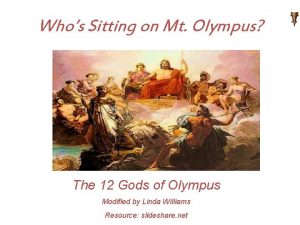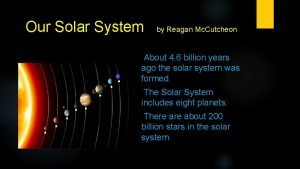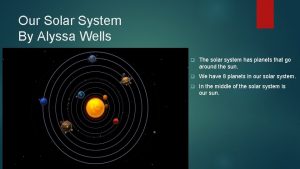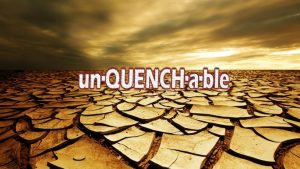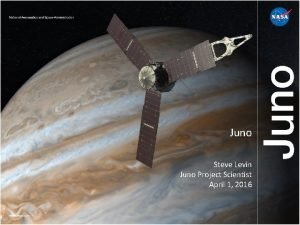MarsRoman God of War Son of Juno and



















































- Slides: 51

Mars—Roman God of War • Son of Juno and Jupiter, and lover of Venus. • The most prominent of the military gods worshipped by the Roman legions. • Festivals held in March. The word Mars is most likely the Latinized form of the Etruscan agricultural god Maris. • Mars originally a Roman god of fertility and vegetation and a protector of farmers and agriculture. • Mars later associated with battle as the Roman Empire expanded. Came to be identified with the Greek god Ares. • Unlike his Greek counterpart, Mars was revered and rivaled Jupiter as the most honored god. • He was also the tutelary god of Rome—regarded as the legendary father of Romulus. All Romans believed they were descendants of Mars & Venus—Make love…not war!


Mars and Earth Compared • Mars' diameter is 1/2 that of Earth's. • It has 10% the mass. • If you weigh 180 pounds on Earth, you would weigh only 68 pounds on Mars. • Mars is half again further from the Sun than the Earth. • The vast deserts of North Africa are no match for the planet-wide desert that is Mars. • While the Earth is host to oceans of liquid water and has a relatively dense water-rich atmosphere, Mars is exceedingly dry, cold, and so far as we know, sterile. • It is believed that Mars lost most of its water to space a long time ago, and any water that remains is frozen at the poles and locked deep in the ground as permafrost. • It is an interesting coincidence that the total surface area of Mars is about the same as the surface area of dry land on the Earth.



Act cal ually… l ‘ca ed th he nal em i’

Orson Welles Broadcasts ‘War of the Worlds’—Oct 30, 1938

Mars global Surveyor Image— 1998 Martian Face—Viking Orbiter 1976

Question The so-called “canals” that Schiaparelli reported seeing upon the surface of Mars were actually ____. 1) an illusion caused by viewing the surface through a telescope with inadequate resolution 2) river valleys, caused by massive floods early in Mars's history 3) an extensive rail network for the super trains that Martians developed for public transportation 4) lines of volcanoes along subduction zone faults in the Martian surface 5) not a natural surface feature but a system of waterways designed to carry water from the poles to the equator built by a civilization suffering from increasing drought

Martian Craters • Syrtis Major seen by Christian Huygens in 1659! • Helles Planitia impact 5 x Texas!

Martian Dust Storms

Martian Topography—Laser ranging by Mars Global Surveyor • Northern lowlands—Southern Highlands—why?

Martian Crustal Dichotomy • • Endogenic: Single-celled mantle convection—material rising in southern hemisphere—falling in northern Impact: Single impact in northern hemisphere (…would be largest impact in Solar System!)

Valles Marineris and Tharsis ‘Bulge’

Central Region of Valles Marineris

Volcanoes in Tharsis Bulge Region

Olympus Mons-Largest Volcano in Solar System

Like Olympus Texas—only Mons—Top a little. View taller! About 3 ‘Everests High!

Question The huge volcano Olympus Mons on Mars and those that make up the Hawaiian Islands on Earth appear to be very similar, but they differ in one important respect. What is this difference? 1) Olympus Mons isn’t on Mars … it’s a mountain along Utah’s Wasatch front. 2) Olympus Mons is formed almost solely of sulfur, whereas the Hawaiian Islands are formed of rock from the solidification of lava. 3) Olympus Mons is a very steep-sided volcano, whereas the volcanoes of Hawaii are rather flat, with gentle slopes right up to their calderas. 4) In the Hawaiian Islands, plate tectonic motion has moved the Pacific Ocean floor over a hot spot, forming a line of volcanoes. No such motion occurred for Olympus Mons over an equivalent hot spot on Mars. 5) The Hawaiian Island volcanos are no longer active but Olympus Mons is.

Mars’ North Pole

Summer at 25 o North Latitude

o Winter at 50 North Latitude

Teardrop Islands—Mariner 9 (1971)

Viking Orbiter Image— 1976 ? ? ?

Water on Mars? Mars Odyssey (2001) • measurement of neutrons generated by cosmic rays. • Deficit indicates water… or ice. • Works down to a depth of 1 meter.

Martian Gullies ? • Image of gullies inside Newton Basin on Mars taken by Mars Global Surveyor (2003) • Slopes face away from sunlight. Most of the gullies occur at latitudes between 30 o and 70 o on the walls of pits developed in the south polar pitted plains. • Continued observation by Hi. RISE aboard MRO (20062017) shows that gully formation is still occurring.

Opportunity Landing Site (2004) Meridianii Planum— Planum Mars Global Surveyor thermal imaging spectrometer found a strong signature of hematite…send Opportunity to investigate • One of flattest places in Solar System • Once a lake bed?

Martian ‘Blueberries’ Utah Blueberries Hematite BB-sized spheres of a type of iron oxide that forms when water runs through sedimentary rock Found in Zion and Capitol Reef national parks, Grand Staircase. Escalante National Monument, Snow Canyon State Park and the Moab area.

In late 2016, scientists using the Mars Reconnaissance Orbiter (MRO) found what they suspected was a buried ice sheet at Mars’s mid-latitudes that holds about as much water as Lake Superior. But they struggled to understand the nature, extent and accessibility of Mars’s subsurface layers until ultimately publishing the results of their study today in Science. Eroded banks in the images above from several sites throughout Mars's mid-latitudes reveal underground bands of bluish material. Spectra of these layers—which start three to six feet beneath the surface—strongly suggest that they are made of water ice.

Yup…Water on Mars Huge ice sheets more than 300 feet deep have been discovered on Mars, making it possible that human astronauts could have access to almost limitless water, scientists said Thursday (1/11/18). The new data, collected in high-resolution three-dimensional images from two U. S. satellites, reveal at least eight locations (between 55 O and 60 O N. and S. ) where massive shelves of water ice are deposited from just below the Martian surface as far deep as 100 meters, or roughly 330 feet, according to the report, which was published in the journal Science.

Question What evidence best supports the hypothesis that Mars might once have contained large quantities of water? 1) Frost that formed on the Viking spacecraft as it cooled after losing the heat that it accumulated during its descent to the Martian surface. 2) Frozen but dust-covered lakes found inside ancient craters. 3) A network of giant canals linking polar and equatorial regions. 4) High resolution images of thick ice deposits exposed along steep eroding slopes on eight scarps taken by Hi. RISE aboard the Martian Reconnaissance Orbiter (MRO). 5) The two Martian landers, Spirit and Opportunity, were halted during their exploration of a Martian crater when they bogged down in deep mud.

Generated … Atmospheres or Heavy Cometary Bombardment By Volcanic Outgassing Mount St Helens… …not Mars!


CO 2 Cycle on Earth warmdown? up on Earth? • What happens if it starts to cool

• Notice… • No inversion! • Why?

No CO 2 Cycle on Mars • • Did Mars have liquid H 2 O early on? What happened to volcanic activity on Mars? What removes CO 2 from the atmosphere … puts it back in? What happened to liquid H 2 O on Mars?

Question Ironically, liquid water that once existed on the surface of Mars, absorbed CO 2 in its atmosphere, which _____. 1) carbonated the water and turned it into steam, which escaped the planet. 2) turned the water into a corrosive acid that killed all emerging life forms. 3) reduced the strength of the greenhouse effect required to keep Mars warm enough for the water to remain liquid. 4) thirsty Martians drank because they loved carbonated water. 5) … all of the above.

Martian Moons—Fear and Panic Phobos (Fear): • Orbital Radius: 9378 km • Orbital Period: 7 hr 39 min Where will Phobos rise and set? Deimos (Panic): • Orbital Radius: 23, 460 km • Orbital Period: 30 hr 18 min • Almost synchronous


• Mission Cost: 1. 5 G$ • Experimental Package: • Weight Limit: 15 kg • Size Limit: 1 cubic foot

The Experiments: 1. LR (Labeled Release) • Based upon searching for biological contaminants in city water supplies 1. A burst of gas production when the medium was organisms first added would ‘eat’ organic nutrients— • Martian 2. However, gas. CO production did not produce , CH , HS 2 4 increase when more solution was added • (as Bathe Martian soil sample in would be expected if living organisms solution 7 were growingcontaining in the medium) organic tagged 3. …. nor when compounds the soil had been preheated 14 and to kill off. Cany microorganisms it might with S 35 — have contained. isotopes of radioactive carbon and sulfur • the was produced by nonliving • gas Analyze gasses surrounding chemistry brought about by oxidizing sample for presence of C 14 agents (H 2 O 2) and perchlorates (Cl. O 4 ) 35 and in the soil. S

2. GEX (Gas EXchange) • Surround Martian soil with inert gas, Helium—see if surrounding atmosphere changes when stimulating metabolic activity of ‘dormant’ organisms by letting water vapor containing 19 organics breath through the soil. • Analyze atmosphere with Gas Chromatograph • Result was negative.

3. PR (Pyrolytic Release) • Surround soil with CO 2 and CO brought from Earth—but in concentrations that mimicked Martian atmosphere. • C tagged with C 14. • Expose to light to stimulate photosynthesis. • Heat soil to 750 C—break apart any organic matter that had incorporated C 14 in its structure • Organic matter detected in 7 of 9 runs. • However, some positive results achieved even on runs where the soil had first been heated to such a high temperature that any microorganisms present would have been killed. • Introduced atmosphere containing radioactive CO 2 and CO was not completely purged before analysis.

3. GCMS (Gas Chromatograph/Mass Spectrometer) • Measure organics in Martian soil and atmosphere directly • Heat soil to 500 C—pass vapors through GCMS • The most sensitive and direct experiment • No organic matter present at level of a few parts per billion! • … the results of LR experiment generated false positives due to oxidizing agents in Martian soil, and possible contamination of chloromethane and dichloromethane in cleaning fluids.

ALH 84001 1 st Meteorite found in 1984 Expedition to Allan Hills, Antarctica SNC meteorite—Stony Achondrite First found: 1. Sherghati, India (1865) 2. El-Nakhla, Alexandria, Egypt, (1911) 3. Chassigny, Haute-Marne, France (1815) This ‘Snicker’ from Mars? • Chemical composition • Trapped gasses Yes… From Mars!

History of ALH 84001 1. Age of meteorite: 4. 1 Billion yrs— when rock 1 st cooled—Rb-Sr dating. 2. Age of carbonite globules: 3. 6 Billion yrs— when Martian crust was ‘shocked’ into fragments by meteorite impact. 3. Cosmic Ray Exposure Age: 17 Million yrs— rock fragment ejected from Mars during 2 nd nearby impact. 4. ‘Terrestrial Age’: 13 Thousand yrs— ALH 84001 lay in Antarctica—C 14 dating (C 14 formed in space by cosmic rays).

Evidence of Martian Life? 1. Carbonate Globules containing magnetite, greigite, pyrrotite. Claim: • Carbonate globules formed in H 2 O. • Minerals bear strong resemblance to mineral alterations caused by primitive bacteria on Earth. 2. PAH’s found—higher concentration on inside. Claim: • When micro-organisms die they break down into PAHs 3. SEM microscopy revealed tiny "ovoids" 20– 100 nm claim: • ‘nanofossils’— fossil remnants of tiny bacteria

Non-Biological Explanations 1. (i) Carbonate globules formed at high temperature >1200 o F (ii) Mineral grains can be formed by non-biological processes (iii) Magnetite, pyrrohite, greigite…can be produced on Earth by magnetotactic bacteria, but Mars has no magnetic field! 2. (i) PAH’s found on other meteorites and dust grains in space (ii) PAH’s produced on Earth by non-biological sources, eg, fire. … But, to be fair, these PAH’s not like others … still no convincing proof that they were produced by biological 3. (i) fossils 100 x smaller than smallest known Earth bacteria! activity (ii)Even smaller than recently discovered ‘nanobacteria’ (iii) too small to store ‘information’ (iv) artifacts of sample preparation process Extraordinary claims require extraordinary evidence— Carl Sagan

Question The exploratory life-science experiments on board the Viking spacecraft lander found evidence _______. 1) of very reactive chemistry in the Martian surface material but no unequivocal evidence of life or remnants of life-forms 2) that primitive life-forms existed on Mars in its early history but that they did not survive 3) That Orson Welles’ 1938 radio broadcast of ‘War of the Worlds’ should have been taken more seriously 4) of a sterile environment and a chemically inert soil in which life could not have existed 5) of primitive life-forms such as elementary bacteria, which could constitute a hazard for human exploration of Mars

Summary of Mercury, Venus, Mars • What astronomers have learned by observing the terrestrial planets from Earth • How the advent of the space age transformed our understanding of Mercury, Venus and Mars • The outstanding features of Mercury, and why its magnetic field came as a surprise • The different ways in which Mercury, Venus, and Mars rotate on their axes • The strange relationship of Venus’ rotation and orbital period to that of the Earth

Summary of Mercury, Venus, Mars • How geologic activity took a very different course on Venus than on Earth, and why it essentially stopped on Mars • The key differences among the atmospheres of Earth, Venus, and Mars • How the atmospheres of Earth, Venus, and Mars evolved to their present states • The evidence that there was once liquid H 2 O on Venus and Mars • What we know about the two small satellites of Mars • The possibility that life once existed on Mars
 Son of juno
Son of juno Whos the goddess of wisdom
Whos the goddess of wisdom Juno awards date
Juno awards date Ares god of war characteristics
Ares god of war characteristics Gods and goddesses names
Gods and goddesses names Juno docdb
Juno docdb Juno genre
Juno genre Hera campana
Hera campana Sni
Sni Multimessenger
Multimessenger Why does juno hate aeneas
Why does juno hate aeneas Juno izumo
Juno izumo Chapter 16 lesson 2 challenges to slavery
Chapter 16 lesson 2 challenges to slavery God is an awesome god and greatly to be praised
God is an awesome god and greatly to be praised What challenges did madison face abroad
What challenges did madison face abroad Korean war vietnam war venn diagram
Korean war vietnam war venn diagram Welcome 1 unit 10 lesson 1
Welcome 1 unit 10 lesson 1 Presidential and radical reconstruction venn diagram
Presidential and radical reconstruction venn diagram Josette dugas
Josette dugas Ich war, du warst
Ich war, du warst Tug of war or tug-of-war
Tug of war or tug-of-war Civil war first modern war
Civil war first modern war Perfect lizz
Perfect lizz Proxy wars cold war
Proxy wars cold war Chapter 30 the war to end war
Chapter 30 the war to end war Chapter 30 the war to end war
Chapter 30 the war to end war Rhea silvia percy jackson
Rhea silvia percy jackson Symbol of mars god
Symbol of mars god Exposure poem annotated
Exposure poem annotated Ares introduction
Ares introduction Gods trojan war
Gods trojan war What happens during autumn
What happens during autumn Roman war god
Roman war god Roman war god
Roman war god Semele roman name
Semele roman name Who worship the war god
Who worship the war god God is a spirit those who worship him
God is a spirit those who worship him Thank you for your nail pierced hands
Thank you for your nail pierced hands Darling of heaven crucified
Darling of heaven crucified Our god is an awesome god vine
Our god is an awesome god vine Our god is an awesome god he reigns
Our god is an awesome god he reigns God is good god is great speed
God is good god is great speed O god you are my god earnestly i seek you
O god you are my god earnestly i seek you God-given virtues that direct us to our loving, triune god.
God-given virtues that direct us to our loving, triune god. God-given virtues that direct us to our loving, triune god.
God-given virtues that direct us to our loving, triune god. My god's bigger than your god
My god's bigger than your god O let the son of god enfold you
O let the son of god enfold you Come come emmanuel son of god appear
Come come emmanuel son of god appear Luke 3:38
Luke 3:38 God sent his son they called him jesus
God sent his son they called him jesus Son of god savior
Son of god savior Behind the scenes
Behind the scenes

